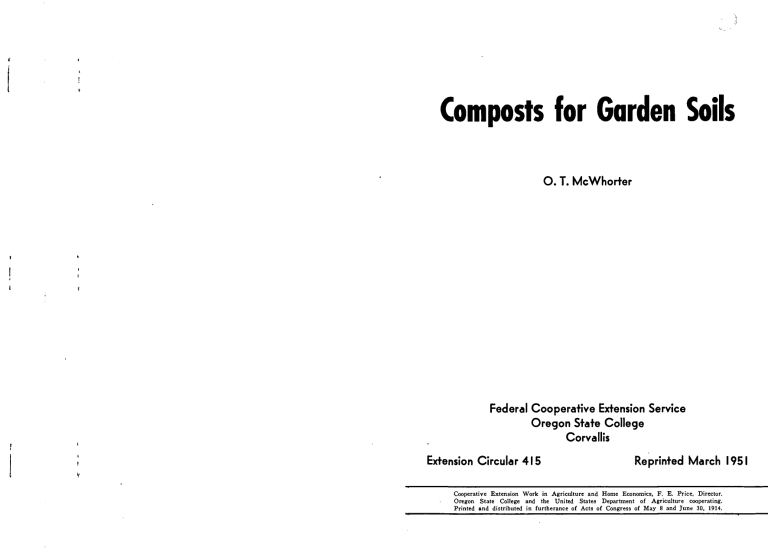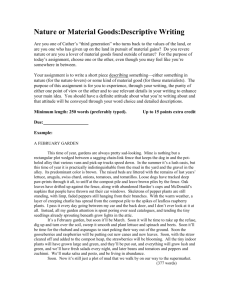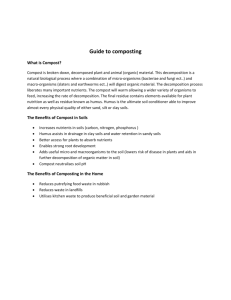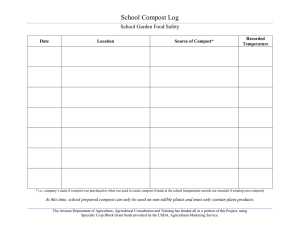Composts for Garden Soils

Composts for Garden Soils
O. T. McWhorter
Federal Cooperative Extension Service
Oregon State College
Corvallis
Extension Circular 415 Reprinted March 1951
Cooperative Extension Work in Agriculture and Home Economics, F. E. Price, Director.
Oregon State College and the United States Department of Agriculture cooperating.
Printed and distributed in furtherance of Acts of Congress of May 8 and June 30, 1914.
Extension Circular 415 Reprinted March 1951
Revision of Ext. Cir. 337
COMPOSTS FOR GARDEN SOILS by
0. T. MCWhorter
Extension Horticulturist
Success in gardening is, first of all, dependent upon a fertile soil.
Soils depleted of organic matter and essential elements of soil fertility are poor garden soils, and poor.crops ean be expected from such soils. Lack of soil fertility has been especially evident in city and town gardens grown on vacant city lots.
Plans should be started in the fall for mere fertile garden soils as one step in growing better garden crops the following season. Composts made from garden refuse, lawn clippings and leaves from shade trees provide fertility for garden soil improvement.
This mimeograph discusses the preparation of composted organic materials to enrich garden soils. When home gardeners do not have access to stable or barnyard manures composts become even more important as a means of soil enrich- ment.
Soil organic matter is a requisite for the production of truck and garden crops. Soil organic matter is of greatest benefit when it is decayed or partial- ly decayed by composting or by other means.
City Garden Soils Generally Lack Fertility
Many home gardeners are handicapped right from the start because of lack of organic matter in the soil. The source of organic matter for home gardens on farms is not so much of a problem because most farms have enough stable manure to supply fertility and organic material for a garden pldt. The addition of 5 to 10 loads of barnyard manure per acre annually is usually sufficient to supply organic matter and fertility for a garden. The application of stable manures to garden soils may be double this amount with good results.
Drawbacks to composting for home.gardens in cities and suburban areas are: lack of suitable space to make the compost pile; labor required for compostingj and the time required to decompose the organic material. Provision for a compost heap should be a part of the garden plan, which in cities may include a screen of some kind to hide it from view.
Composting Materials
Sources of organic matter for composting may be found in the leaves from maple trees, oak trees, deciduous ornamentals, or deciduous fruit trees. Clip- pings from the lawn may be used, Pea vines, bean vines, cabbage leaves, beet tops, carrot tops, and all other organic materials from the garden are valuable for composting. None should be destroyed or carted away in the garbage.
Amounts of nitrogen, phosphoric acid, and potash that may be found in 100 pounds of organic materials commonly available to home gardeners from vfhich composts may be made:
Material, 100 lbs. Nitrogen
Phosphoric
Acid
P
2
0
3
Potash
K
2
0
Peach Leaves
Oak Leaves
Grape Leaves
Pear Leaves
Apple Leaves
Cherry Leaves
Raspberry Leaves
Garden Pea Vines
Red Clover, Green
Vetch Hay
Alfalfa Hay
Corn Stalks
Immature Grass
,9 pounds
.8 ' it.
.45' ii
.7 ti
1.00 n
.6 ti it 1.35
II
-.25
.55 II
2.8 it. ti 2.45
,75
1,00 tt ti
.15 pounds
.35 "
.1 «
.12 «
.15 »
.11 "
.27 »
.05 "
.13 ••
■
.75 »
.5 "
.40 «
.5
.60 pounds
.15 "
.35 "
.4 "
• 35 "
,72 »
.63 »
.7 »
.5 "
2,3 "
2.10 "
.9 " .
1.2 "
Building the Compost Pile .
The compost pile may be any length and width to suit the convenience of the maker and may be built five feet in height.
One method of. making a compost pile step by step is:
(1) Pile leaves or other organic refuse about one foot deep covering the space set aside for the compost heap.
(2) Over this layer of. leaves, straw, or other organic material spread a nitrogen fertilizer. This nitrogen fertilizer may be sulfate of ammonia, if available, cyanamid, nitrate.of soda or ammonium nitrate at the rate of one-fourth to one-half pound per square yard of compost area. Also add superphosphate at the rate of one-fourth pound per square yard, and lime, preferably ground lime rock, at the rate of one-fourth pound for each square yard-. In the place of lime, one-half pound of wood ashes may be used per square yard.
(Do not use more ashes than this.) Each successive layer of leaves or other bulky organic material should receive the same amounts of fertilizers per square yard.
(3) Add water enough to make the layer moist. Rapid decomposing of bulky organic materials in compost heaps depends upon the addition of chemical fertilizers and upon keeping the mass, of material moist.
(4.) On this first layer of leaves, straw, or other organic material, place a thin layer of stable manure, poultry manure, or manure from rabbit hutches,.or a layer of the richest soil available.
This layer of manures or soil or. both is important and necessary for the rapid decomposition of the compost pile. This, layer should be one or two'inches.deep. Manures are desirable for this layer but not a necessity. Rich soil supplies soil bacteria which expedite the rotting of the. materials.
(5) Add successive layers of organic material to the compost heap as already directed until it is completed.
(6) Add water at regular intervals after the pile is completed to keep the compost heap in a tooist condition but not dripping wet.
(7) If rainfall is excessive, a roof should be provided to ward off or drain away the excess water which might leach valuable fertility from the compost pile.
Mix Compost Piles at Stated Intervals
After the compost pile has been completed for eight, to ten weeks, it should be forked and turned over or replied. After a lapse of another three weeks, fork or turn it again to thoroughly mix it. The forking and turning process is to more thoroughly mix the- compost and promote rotting and decompo- sition.
The outer edges of the compost heap should be kept slightly higher than the center so that drainage will be towards the center of the pile.
The plan just outlined for making composts may vary somewhat from methods followed by greenhouse operators and flower gardeners wherein manure in large lots is mixed with earth to prepare a very fertile soil for plant growing.
Work Compos ted Material Into the Soil
Compost piles made in the fall of the year when leaves fall should provide rotted organic matter rich in fertilizer values to spade, or plow under next spring. This compsst material may be broadcast over the garden area just before spading or plowing takes place.
Acknowledgment is made to A. S. King, Extension Specialist in
Soils, and A. N. Roberts, Instructor in Horticulture, for suggestions relating to this manuscript.
References;
Stephenson, R. E. 19-41. Humus for Oregon Soils,
Agricultural Experiment Station, Oregon State College,
Station Circular 143.
U.S. Department of Agriculture. 1940. Technology on the Farm.






